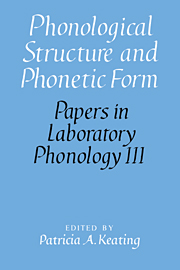Book contents
- Frontmatter
- Contents
- List of contributors
- Acknowledgments
- 1 Introduction
- I Intonation
- 2 Articulatory evidence for differentiating stress categories
- 3 “Stress shift” as early placement of pitch accents: a comment on Beckman and Edwards
- 4 Constraints on the gradient variability of pitch range, or, Pitch level 4 lives!
- 5 “Gesture” in prosody: comments on the paper by Ladd
- 6 What is the smallest prosodic domain?
- 7 The segment as smallest prosodic element: a curious hypothesis
- II Syllables
- III Feature Theory
- IV Phonetic Output
- Index of subjects
- Index of names
4 - Constraints on the gradient variability of pitch range, or, Pitch level 4 lives!
Published online by Cambridge University Press: 26 February 2010
- Frontmatter
- Contents
- List of contributors
- Acknowledgments
- 1 Introduction
- I Intonation
- 2 Articulatory evidence for differentiating stress categories
- 3 “Stress shift” as early placement of pitch accents: a comment on Beckman and Edwards
- 4 Constraints on the gradient variability of pitch range, or, Pitch level 4 lives!
- 5 “Gesture” in prosody: comments on the paper by Ladd
- 6 What is the smallest prosodic domain?
- 7 The segment as smallest prosodic element: a curious hypothesis
- II Syllables
- III Feature Theory
- IV Phonetic Output
- Index of subjects
- Index of names
Summary
The Free Gradient Variability hypothesis
One of the central assumptions of most work on intonation is that pitch range can vary gradiently to convey differences in emphasis or prominence. Indeed for most investigators this is not a “central assumption” but simply an indisputable fact: it is trivial to observe that when you raise your voice your utterance sounds more emphatic, and also – this is the gradient part – that the more you raise your voice the more emphatic it sounds. I don't propose to dispute either this fact, or the often tacit assumption that such variation in pitch range is “paralinguistic” and largely beyond the scope of phonological analysis.
However, the general observation that pitch range can vary gradiently and paralinguistically – which I don't dispute – has found its way into many theories of intonational phonology in the form of a much more specific assumption about the nature and extent of gradient variability – which I have been disputing for some years now. The assumption is this: the pitch range on any pitch accent can be gradiently varied to convey differences in “emphasis” or “prominence,” and this variation is largely independent of, or unconstrained by, the pitch-range variation on any other part of the utterance. I will refer to this assumption as the Free Gradient Variability (FGV) hypothesis.
The FGV hypothesis is illustrated in the following two quotes, which display strikingly similar assumptions despite the differences due to the three decades of theoretical change that separate them.
- Type
- Chapter
- Information
- Phonological Structure and Phonetic Form , pp. 43 - 63Publisher: Cambridge University PressPrint publication year: 1994
- 6
- Cited by

